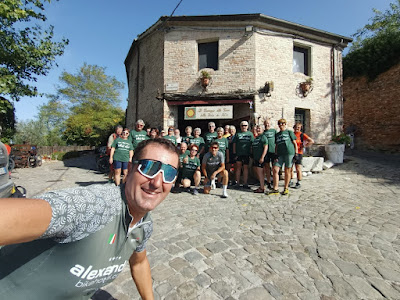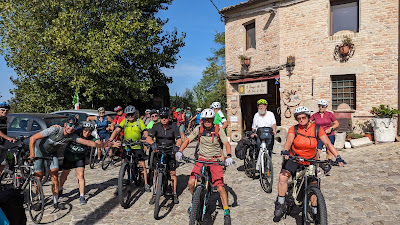martedì 31 ottobre 2023
lunedì 30 ottobre 2023
Extra sound
Si posso concretizzare così Concerti all’alba o al tramonto in un luoghi raggiungibili «solo» in bicicletta; Bike Days con musica diffusa su tutto il percorso; Cronoscalate con colonna sonora personalizzata, oltre ad altri elementi caratterizzanti che definiscono la piattaforma di comunicazione e le installazioni sonore diffuse.
domenica 29 ottobre 2023
sabato 28 ottobre 2023
Vicini alle nuvole
Da Van Impe a Pogacar, passando per Pantani, Chiappucci, Nibali e Contador, storie di successi e attacchi, di fantasia e coraggio nel ciclismo, per rendere omaggio alla figura dello scalatore, che fa saltare sulla sedia gli appassionati ogni volta che scatta su una salita.
Il ciclismo ha varie declinazioni, ma nell’immaginario collettivo il più delle volte, quando parliamo dei grandi giri a tappe (Tour, Giro d’Italia e Vuelta), le imprese memorabili sono state firmate dai grandi scalatori.
Il lavoro a quattro mani dei due telecronisti di Eurosport Luca Gregorio e Riccardo Magrini è basato sulle emozioni che dieci scalatori scelti hanno suscitato e permette di scoprire la grandezza delle imprese che hanno segnato le loro carriere.
Il volume contiene la prefazione di un fan d'eccezione: Mauro Corona, scrittore, alpinista e grande appassionato di ciclismo.
From Van Impe to Pogacar, passing through Pantani, Chiappucci, Nibali and Contador, stories of successes and attacks, of imagination and courage in cycling, to pay homage to the figure of the climber, who makes enthusiasts jump in their seats every time he sprints on a climb.
Cycling has various declinations, but in the collective imagination most of the time, when we talk about the great stage tours (Tour, Giro d'Italia and Vuelta), the memorable feats were signed by the great climbers.
The collaborative work of the two Eurosport commentators Luca Gregorio and Riccardo Magrini is based on the emotions that ten chosen climbers aroused and allows us to discover the greatness of the feats that have marked their careers.
The volume contains the preface by an exceptional fan: Mauro Corona, writer, mountaineer and great cycling enthusiast.
giovedì 26 ottobre 2023
Gli accessori che rendono la tua bicicletta sicura
Alcuni dei dispositivi che vedremo sono da applicare o montare sulla bici, altri da indossare. Nessuno di loro stravolgerà il veicolo. È doveroso però ricordare i dispositivi di protezione obbligatori e previsti dal Codice della Strada per la circolazione in ambiente urbano, quali gilet catarifrangente e luci di posizione.
Caschi con sistema MIPS
Il casco è un dispositivo di protezione che andrebbe sempre indossato quando siamo in bici. I dati continuano a confermare la sua utilità in termini di protezione e, nonostante il dibattito sulle conseguenze di un suo eventuale obbligo normativo, indossarlo dovrebbe essere un’imposizione personale. Forse poi non tutti sanno che il settore ha avuto un’evoluzione importante nell’ultimo periodo e tra i modelli oggi disponibili possiamo scegliere quelli dotati del sistema MIPS.
Il MIPS, acronimo di Multi-Directional Impact Protection, è una sotto-struttura interna al casco capace di proteggere il cranio dagli urti rotazionali, quelli più pericolosi per il cervello. È in pratica un involucro in grado di ruotare in maniera indipendente rispetto alla calotta esterna, assorbendo così l’impatto rotazionale che può generarsi durante una caduta in velocità. Pur non essendo uno standard obbligatorio, consigliamo vivamente l’utilizzo di caschi dotati di sistema MIPS perché possono fare la differenza in alcuni casi. A completamento del casco sarebbe utile aggiungere una visiera o utilizzare degli occhiali trasparenti per proteggere gli occhi: a volte basta incrociare un insetto nel momento sbagliato per restare accecati e perdere il controllo del mezzo.
Dispositivi anticaduta
Ancora meno persone sanno dell’esistenza dei sistemi anticaduta, anzi, del sistema. Già, perché attualmente ne è disponibile soltanto uno, salvo particolari bici che già possiedono qualcosa di simile al loro interno. Il prodotto in questione si chiama Bypoint ed è un piccolo dispositivo che può essere montato su qualsiasi bicicletta. Il suo funzionamento è tanto semplice quanto utile. Se un ciclista cade dal veicolo durante un giro in bici il sistema se ne accorge immediatamente: per prima cosa chiede al malcapitato, tramite un altoparlante, se è tutto ok; se la persona non risponde, il dispositivo avvisa automaticamente tre contatti pre-programmati tramite un messaggio SMS.
Inoltre, condivide le coordinate GPS con l’assistenza Bypoint affinché sia il personale interno che i servizi di emergenza possano arrivare spediti sul luogo dell’incidente. Dagli studi emerge che un’assistenza rapida è fondamentale per limitare le conseguenze: i chirurghi traumatologici parlano spesso di “ora d’oro”, ma purtroppo, dopo una caduta, non sempre le persone sono in grado di cercare aiuto o di chiamare il 112 in modo autonomo. Se girano da sole a volte rimangono bloccate in mezzo al nulla e non hanno idea di dove si trovino: a loro è particolarmente indicato un dispositivo come Bypoint.
Telecamere retrovisori
Se non siamo amanti degli specchietti ma ci teniamo comunque alla sicurezza, Cycliq Fly 6 è un dispositivo che può fare al caso nostro. Sapere cosa sta succedendo dietro è importante quasi quanto vedere quello che c’è davanti: auto e moto tendono spesso a superare le bici standogli molto attaccate e basta una piccola manovra per finire nella loro traiettoria. Il ciclista deve stare dieci volte più attento rispetto agli altri e avere una visione il più possibile completa di quello accade intorno a lui.
Cycliq Fly 6 viene incontro a questa esigenza: si tratta di una piccola telecamera collegata tramite bluetooth al nostro smartphone, sul cui schermo possiamo vedere le sue riprese in tempo reale. Si monta nella parte posteriore e copre un angolo visivo di 130°, aumentando notevolmente la nostra sicurezza in corsa. Inoltre, nel malaugurato caso in cui dovessimo finire coinvolti in un incidente, Fly 6 registra tutto l’accaduto precedente, salvandolo sulla SD Card in modo che nulla possa essere sovrascritto, e congiuntamente invia un segnale di aiuto nel caso fossimo in contesti isolati.
Airbag
Parlando ancora di cadute, sappiate che esistono anche gli airbag per ciclisti. Per fortuna non si tratta di accessori prettamente tecnici, bensì di indumenti che mimetizzano le loro funzioni attraverso un design gradevole. È il caso di Urban Circus che, in collaborazione con il marchio Helite, ha prodotto una giacca esteticamente bella con al suo interno un sistema airbag. Unisex, impermeabile, dotata di cappuccio e di ampie superfici riflettenti par garantire la massima visibilità, questa giacca 2.0 offre una protezione davvero a tutto tondo.
Ricordiamoci che a volte anche banali cadute possono trasformarsi in veri e propri incubi, provocando dolori persistenti capaci di influire negativamente sulla nostra vita. La giacca airbag di Helite si gonfia in soli 80 millisecondi non appena rileva una collisione o una caduta imminente. Come? Beh, il sistema è in effetti tanto ingegnoso quanto efficace. Praticamente si basa sull’installazione di due sensori, uno sotto la sella della bici, l’altro nel giubbotto. I due comunicano costantemente e se rilevano un’espulsione (salto dalla posizione di guida) o un qualche tipo di impatto, mandano indicazione di gonfiare immediatamente la giacca.
Una volta utilizzato il meccanismo bisogna ricaricarlo con un’altra cartuccia di gas e l’unico limite di questa giacca potrebbe essere quello di utilizzarlo con il caldo.
mercoledì 25 ottobre 2023
SUMMER BIKE & BEACH
Prenota la tua vacanza Bike All’Alexander con la tua dolce metà o un amico/a nei mesi di luglio e agosto per continuare a pedalare e … goderti anche il mare!
- Durata del Soggiorno: 7 notti (8 giorni)
- Trattamento di Mezza Pensione: prima colazione fino alle ore 11.00 e cena à la carte con 3 menù a scelta (pesce, carne e vegetariano) e ampio buffet di antipasti.
- N° 3 uscite in bici con la nostra guida esperta.
Potrai pedalare dalle 6.30 alle 10.00, tornare in hotel e gustare una ricca colazione fino alle ore 11.00. - Camera matrimoniale dotata di tanti confort e balcone e vista mare.
- Drink di benvenuto e consegna della nostra bike t-shirt.
- Deposito sicuro per 80 biciclette dotato di video sorveglianza, angolo officina attrezzata per le piccole riparazioni e colonnina per lavaggio e manutenzione bici
- Meccanico esperto a disposizione per piccole riparazioni e assistenza
- Recupero bici e ciclista in caso di guasto
- Percorsi dettagliati per cicloturismo da strada con cartina e gpx
- Servizio di lavanderia per l’abbigliamento tecnico
- Banane, sali e acqua minerale per le tue uscite in bicicletta
- Sauna e massaggi su prenotazione e a pagamento
- Piscina e idromassaggio esterni riscaldati
- Wi-fi gratuito in tutta la struttura (fibra)
- Convenzione con negozi di biciclette specializzati
- Potrai usufruire gratuitamente del nostro parcheggio privato adiacente all’hotel, con la possibilità di ricaricare la tua auto elettrica.
- Se vieni in compagnia (2 persone) ti regaliamo il servizio spiaggia: 1 ombrellone e 2 lettini ai Bagni 42/44 a partire dalla 4° fila.
Prezzo a partire da € 128,00 a persona al giorno in camera doppia.
– 10% per prenotazioni entro il 31. 12. 2023 (offerta valida per soggiorni di minimo 1 settimana) e -10% al nostro pro bike shop
Tassa di soggiorno: € 2,50 al giorno e per persona per un massimo di 7 giorni
Book your Bike holiday at the Alexander with your partner or a friend in July and August: keep pedaling and…enjoy the beach!
- 1 week holiday: 7 nights (8 days)
- Half-Board Treatment: breakfast until 11:00 am and à la carte dinner with a choice of 3 menus (fish, meat, and vegetarian) and a large buffet of appetizers.
- N°3 bike rides with our expert guide.
- You can ride from 6:30 am to 10:00 am, return to the hotel, and enjoy a hearty breakfast until 11:00 am.
- Double room with many comforts and balcony with sea view.
- Welcome drink and delivery of our bike t-shirt.
- Secure storage for 80 bicycles with video surveillance, an equipped workshop corner for minor repairs, and a column for bike washing and maintenance.
- Expert mechanic available for minor repairs and assistance.
- Bike and cyclist recovery in case of breakdown.
- Detailed road cycling routes with a map and GPX.
- Laundry service for technical clothing.
- Bananas, salts, and mineral water for your bike rides.
- Sauna and massages by reservation and for a fee.
- Heated outdoor pool and jacuzzi.
- Free Wi-Fi.
- Agreement with specialized bicycle shops.
- Free private parking, with the option to recharge your electric car.
- If you come with a companion (2 people), we’ll gift you the beach service: 1 beach umbrella and 2 sun beds at Bagni 42/44 starting from the 4th row.
Starting from just €128.00 per person per day in a double room.
10% for bookings before 31. 12. 2023 (offer valid for stays of at least 1 week) and -10% at our pro bike shop.
City tax: €2.50 per day per person, up to a maximum of 7 days.
martedì 24 ottobre 2023
Il diritto di pedalare in sicurezza
Commissione Europea, Parlamento Europeo e Consiglio Europeo hanno proclamato la propria adesione alla Declaration on Cycling, la Dichiarazione sulla bicicletta. Si tratta di un documento nel quale l’UE tutta ha evidenziato i benefici multipli della mobilità ciclistica in termini di tutela della salute pubblica, dell’economia, del mercato del lavoro e dell’ambiente. La notizia è stata subito accolta positivamente dalla ECF, la federazione bike friendly europea che raggruppa le associazioni cicloambientaliste europee, tra cui FIAB, e svolge da anni un lavoro di advocacy nelle istituzioni. Questo è il commento di Francesco Baroncini, componente del consiglio di amministrazione di ECF. “La Dichiarazione è un grande successo di ECF ed è il frutto di anni di lavoro al quale anche io ho dato il mio contribuito. Siamo molto contenti di questa dichiarazione perché, a leggere attentamente, si trova tutto quello che le associazioni cicloambientaliste hanno sempre detto. È stata poi molto positiva la collaborazione con le industrie, che ha portato a inserire qualsiasi tipo di mezzo a due ruote a propulsione umana nel documento. Pur essendo una dichiarazione senza immediate ricadute pratiche, è anche vero che toglie ogni qualsiasi scusa alle autorità, anche locali. Tutti possono sentirsi impegnati a fare. Il compito di ECF è ora continuare a lavorare a Bruxelles, mentre FIAB e le associazioni hanno in mano uno strumento potente in più per lavorare. Ringrazio infine tutte le persone dello staff di ECF per questo importante risultato”.
Prima di passare in rassegna alcuni punti della Dichiarazione sulla bicicletta voluta dalle principali istituzioni politiche dell’Unione Europea ricordiamo che è stata la commissaria ai Trasporti dell’UE Adina Valean a presentare i contenuti del documento a Siviglia a inizio ottobre. In un post su X (l’ex social Twitter), Valean ha ricordato il contributo al PIL europeo dell’industria legata alla bicicletta. Dal 2012 al 2022 le biciclette prodotte da società europee sono aumentate del 29%, arrivando a sfiorare quasi le 15 milioni di unità. Sempre Valean ha poi spiegato che questo trend riguarda anzitutto Paesi come Portogallo, Romania, Italia, Germania e Polonia.
A meno di un anno dalle elezioni Europee del giugno 2024 la Dichiarazione sulla bicicletta diventa anche un impegno politico preso dall’attuale Commissione in vista del futuro e in un’ottica di eredità per chi siederà nelle sedi istituzionali. Gli obiettivi riguardano la creazione di un network europeo di ciclabili e ciclovie, più collegamenti e infrastrutture per incentivare l’intermodalità e più parcheggi sicuri per proteggere la quota urbana degli spostamenti in sella.
Nel preambolo si parla anzitutto di trasporti, definendo quelli sostenibili come “essenziali per raggiungere gli obiettivi dell’UE in materia di clima, inquinamento zero ed efficienza energetica”. La bicicletta in questo senso è uno dei mezzi “più sostenibili, salutari ed efficienti, con un notevole potenziale di sostegno alla decarbonizzazione del trasporto urbano e al raggiungimento dell’obiettivo europeo di ridurre le emissioni nette di gas serra di almeno il 55%”. Sempre nel preambolo della Dichiarazione sulla bicicletta è ribadito un concetto fondamentale: più infrastrutture ciclabili ci sono e più le persone saranno spinte a pedalare.
Nel Capitolo 1 le istituzioni che hanno sottoscritto il documento si impegnano a “incoraggiare le aziende, le organizzazioni e le istituzioni a promuovere l’uso della bicicletta attraverso programmi di gestione della mobilità, come gli incentivi per andare al lavoro in bicicletta, la fornitura di biciclette aziendali, parcheggi e strutture adeguate per le biciclette e l’uso di servizi di consegna in bicicletta”.
Nel Capitolo 2 si cita il tema dell’inclusione e del diritto di tutti alla mobilità. “L’uso della bicicletta dovrebbe essere accessibile a tutti, indipendentemente dal livello di reddito e dovrebbe essere promossa in quanto positiva per la salute fisica e mentale”. Ecco allora che le istituzioni UE, ad esempio, si impegnano ad “aumentare l’uso della bicicletta per promuovere l’inclusione sociale, prestando particolare attenzione alle esigenze di donne, bambini, anziani e gruppi vulnerabili ed emarginati”.
Nel Capitolo 3 della Dichiarazione sulla bicicletta si parla di infrastrutture con l’impegno a “lavorare per la creazione di una rete ciclabile coerente nelle città e a migliorare la connettività tra le aree suburbane e rurali e i centri urbani”. Per sbloccare il potenziale della bicicletta, espressione ripresa dal documento nel Capitolo 4, servono ovviamente investimenti che vadano a potenziare servizi già esistenti e coprire quelle zone in cui finora sono stati invece assenti.
Nel Capitolo 5 si parla di sicurezza stradale, tema sul quale la Federazione Italiana Ambiente e Bicicletta si batte da sempre. Ecco allora che Parlamento, Commissione e Consiglio si impegnano a “lavorare per far sì che la Visione Zero (nessun morto sulle strade entro il 2050) diventi una realtà, anche per gli utenti vulnerabili della strada, raggiungendo un obiettivo intermedio di riduzione del 50% degli incidenti mortali e dei feriti gravi entro il 2030”.
Nel Capitolo 6 si cita quanto poi espresso dalla Commissaria UE ai Trasporti, evidenziando l’importanza dell’industria bike friendly nella strategia green del vecchio continente. Non potevano mancare riferimenti all’intermodalità e al cicloturismo (Capitolo 7), fattori che portano sviluppo e crescita nei territori e benessere ai cittadini.
Da ultimo, ma non meno importante, il Capitolo 8 della Dichiarazione sulla bicicletta parla di dati, ovvero quelle informazioni che se raccolte e rese disponibili ai decisori politici aiuterebbero a inquadrare trend, conoscere meglio lo stato dell’arte. L’UE si impegna in questo senso a stabilire un insieme di criteri condivisi tra tutti i membri per monitorare quanto un territorio sia bike friendly.
The European Commission, the European Parliament and the European Council have proclaimed their adherence to the Declaration on Cycling. This is a document in which the entire EU has highlighted the multiple benefits of cycling mobility in terms of protecting public health, the economy, the labor market and the environment. The news was immediately welcomed positively by the ECF, the European bike friendly federation which brings together European cycling environmental associations, including FIAB, and has been carrying out advocacy work in the institutions for years. This is the comment of Francesco Baroncini, member of the ECF board of directors. “The Declaration is a great success of the ECF and is the result of years of work to which I also contributed. We are very happy with this statement because, if you read carefully, you will find everything that the cycling environmental associations have always said. The collaboration with the industries was also very positive, which led to the inclusion of any type of human-powered two-wheeled vehicle in the document. Although it is a declaration without immediate practical implications, it is also true that it removes any excuse from the authorities, even local ones. Everyone can feel busy doing. ECF's task is now to continue working in Brussels, while FIAB and the associations have an additional powerful tool in their hands for working. Finally, I thank all the people on the ECF staff for this important result."
Before reviewing some points of the Declaration on cycling desired by the main political institutions of the European Union, let us remember that it was the EU Transport Commissioner Adina Valean who presented the contents of the document in Seville at the beginning of October. In a post on X (the former social network Twitter), Valean recalled the contribution to the European GDP of the bicycle industry. From 2012 to 2022, bicycles produced by European companies increased by 29%, reaching almost 15 million units. Valean then explained that this trend primarily concerns countries such as Portugal, Romania, Italy, Germany and Poland.
Less than a year before the European elections in June 2024, the Declaration on the bicycle also becomes a political commitment made by the current Commission with a view to the future and with a view to legacy for those who will sit in institutional offices. The objectives concern the creation of a European network of cycle paths and cycle paths, more connections and infrastructures to encourage intermodality and more safe parking to protect the urban share of cycling.
The preamble talks first of all about transport, defining sustainable transport as "essential to achieving the EU's climate, zero pollution and energy efficiency objectives". In this sense, the bicycle is one of the "most sustainable, healthy and efficient means of transport, with a significant potential to support the decarbonisation of urban transport and the achievement of the European objective of reducing net greenhouse gas emissions by at least 55%". Also in the preamble of the Declaration on cycling a fundamental concept is reiterated: the more cycling infrastructure there is, the more people will be encouraged to cycle.
In Chapter 1 the institutions that have signed the document undertake to "encourage companies, organizations and institutions to promote the use of cycling through mobility management programmes, such as incentives for cycling to work, the provision of company bicycles, adequate parking and facilities for bicycles and the use of bicycle delivery services”.
Chapter 2 mentions the theme of inclusion and everyone's right to mobility. “Cycling should be accessible to all, regardless of income level and should be promoted as it is good for physical and mental health.” This is why the EU institutions, for example, are committed to "increasing the use of bicycles to promote social inclusion, paying particular attention to the needs of women, children, the elderly and vulnerable and marginalized groups".
In Chapter 3 of the Cycling Declaration we talk about infrastructure with the commitment to "work towards the creation of a coherent cycling network in cities and to improve connectivity between suburban and rural areas and urban centres". To unlock the potential of the bicycle, an expression taken up by the document in Chapter 4, investments are obviously needed to strengthen existing services and cover those areas where they have been absent so far.
Chapter 5 talks about road safety, a topic on which the Italian Environment and Bicycle Federation has always fought. Thus, Parliament, Commission and Council commit themselves to "work to ensure that Vision Zero (no deaths on the roads by 2050) becomes a reality, including for vulnerable road users, reaching an intermediate objective of a 50% reduction of fatal accidents and serious injuries by 2030”.
Chapter 6 cites what was later expressed by the EU Transport Commissioner, highlighting the importance of the bike friendly industry in the green strategy of the old continent. References to intermodality and cycle tourism could not be missing (Chapter 7), factors that bring development and growth to the territories and well-being to citizens.
Last but not least, Chapter 8 of the Bicycle Declaration talks about data, i.e. information which, if collected and made available to political decision-makers, would help to frame trends and better understand the state of the art. In this sense, the EU is committed to establishing a set of criteria shared among all members to monitor how bike friendly an area is.
domenica 22 ottobre 2023
sabato 21 ottobre 2023
Il diario del ciclista
Ti è mai capitato di...
correre una tappa del Tour de France?
Prendere parte all’Eroica?
Pedalare in un velodromo?
Questo diario, meravigliosamente illustrato, può essere utilizzato per scrivere note sulle proprie imprese sportive, le esperienze, sui propri miti ma anche sulla vita di tutti i giorni. È un libro che incoraggia il lettore a spingere un po’ più in là il suo limite e a portare a un altro livello il suo pedalare; il lettore è chiamato a spuntare le sfide man mano che le avrà completate.
Con 30 pagine illustrate e circa 100 pagine bianche da scrivere, è il perfetto diario per ogni occasione!
Have you ever happened to...
run a stage of the Tour de France?
Taking part in the Eroica?
Cycling in a velodrome?
This beautifully illustrated diary can be used to write notes on your sporting exploits, experiences, on your myths but also on everyday life. It is a book that encourages the reader to push his limit a little further and take his cycling to another level; the reader is asked to tick off the challenges as he completes them.
With 30 illustrated pages and around 100 blank pages to write on, it's the perfect diary for any occasion!
giovedì 19 ottobre 2023
Giro d'Italia 2024
Al Teatro Sociale di Trento, nei giorni de Il Festival dello Sport, è stato presentato il percorso del 107° Giro d’Italia in programma dal 4 al 26 maggio 2024.
Al Vernissage, presentato da Cristina Fantoni e Nino Morici, hanno partecipato molti volti noti dello sport, dello spettacolo, delle istituzioni e delle aziende che fanno e faranno parte della grande famiglia del Giro d’Italia.
Sul palco del teatro sono intervenuti anche il vincitore dell’ultimo Giro d’Italia, Primož Roglič, Filippo Ganna, Jai Hindley e il tre volte Campione del Mondo Peter Sagan oltre a un grande corridore che ha fatto la storia della Corsa Rosa come Vincenzo Nibali. Per svelare il Trofeo e parlare di Giro d’Italia Women due Campionesse del pedale quali Elisa Longo Borghini e Letizia Paternoster. Tra le istituzioni presenti anche Francesco Lollobrigida, Ministro dell’Agricoltura, della Sovranità Alimentare e delle Foreste, e Cordiano Dagnoni, Presidente della Federazione Ciclistica Italiana.
A fare gli onori di casa il Presidente di RCS Mediagroup, Urbano Cairo, l’Amministratore Delegato di RCS Sport, Paolo Bellino, il Direttore del Giro d’Italia, Mauro Vegni, e il Direttore de La Gazzetta dello Sport, Stefano Barigelli.
Lo sapevi che?
- La Regione Piemonte ospiterà la Grande Partenza del Giro d’Italia per la quarta volta. I precedenti sono: 1961, in occasione del Centenario dell’Unità d’Italia il via fu a Torino con una tappa denominata “Trittico Tricolore” che comprendeva 3 circuiti (Bianco, Rosso e Verde). Il vincitore di tappa fu Miguel Poblet. 2011, festeggiamenti dei 150 anni dell’Unità d’Italia, la partenza è con la Venaria Reale-Torino, cronosquadre vinta dalla HTC-Highroad e maglia Rosa a Marco Pinotti. 2021, partenza con una cronometro individuale a Torino, vinta da Filippo Ganna.
- Il 4 maggio, giorno della prima tappa, ricorreranno i 75 anni dalla tragedia di Superga. La Corsa Rosa renderà omaggio agli Invincibili del Grande Torino transitando a Superga.
- Il Santuario D’Oropa sarà la Montagna Pantani del Giro d’Italia a 25 anni dall’impresa del Pirata.
- 45° arrivo di tappa a Napoli, che ospiterà l’arrivo della Corsa Rosa per il terzo anno di fila.
- Sono 7 le partenze inedite: San Francesco al Campo (tappa 2), Foiano di Val Fortore (tappa 11), Martinsicuro (tappa 12), Castiglione delle Stiviere (tappa 14), Manerba del Garda (tappa 15), Santa Cristina Valgardena (tappa 17) e Mortegliano (tappa 19).
- 6 invece gli arrivi inediti: Andora (tappa 4), Rapolano Terme (tappa 6), Cusano Mutri (tappa 10), Desenzano del Garda (tappa 14), Santa Cristina Valgardena (tappa 16), Passo Brocon (tappa 17).
- Il Passo dello Stelvio è Cima Coppi per l’11^ volta. Con i suoi 2758 metri, è la quota più alta mai toccata dal Giro d’Italia.
- L’unico sconfinamento del Giro d’Italia avverrà nella 15^ tappa con arrivo a Livigno. La Corsa Rosa transiterà in Svizzera.
- Roma ospita il Grande Arrivo per la sesta volta nella storia. I precedenti sono 1911, 1950, 2009, 2018 e 2023.
At the Teatro Sociale in Trento, during the days of the Sports Festival, the route of the 107th Giro d'Italia scheduled from 4 to 26 May 2024 was presented.
Many faces participated in the Vernissage, presented by Cristina Fantoni and Nino Morici well-known people in sport, entertainment, institutions and companies who are and will be part of the great Giro d'Italia family.
Also speaking on the theater stage were the winner of the last Giro d'Italia, Primož Roglič, Filippo Ganna, Jai Hindley and the three-time World Champion Peter Sagan as well as a great rider who made the history of the Corsa Rosa like Vincenzo Nibali . To reveal the Trophy and talk about the Giro d'Italia Women, two pedal champions such as Elisa Longo Borghini and Letizia Paternoster.
Among the institutions present also Francesco Lollobrigida, Minister of Agriculture, Food Sovereignty and Forestry, and Cordiano Dagnoni, President of the Italian Cycling Federation. Doing the honors were the President of RCS Mediagroup, Urbano Cairo, the CEO of RCS Sport, Paolo Bellino, the Director of the Giro d'Italia, Mauro Vegni, and the Director of La Gazzetta dello Sport, Stefano Barigelli.
Do you know?
- The Piemonte Region will host the Grande Partenza of the Giro d'Italia for the fourth time. The precedents are: 1961, on the occasion of the Centenary of the Unification of Italy, the start was in Turin with a stage called "Trittico Tricolore" which included 3 circuits (White, Red and Green). The stage winner was Miguel Poblet. 2011, celebrations of the 150th anniversary of the Unification of Italy, the start is with the Venaria Reale-Turin, team time trial won by HTC-Highroad and pink jersey for Marco Pinotti. 2021, starting with an individual time trial in Turin, won by Filippo Ganna.
- May 4th, the day of the first stage, will mark 75 years since the Superga tragedy. The Corsa Rosa will pay homage to the Invincibles of Grande Torino by passing through Superga.
- The Sanctuary of Oropa will be the Montagna Pantani of the Giro d'Italia 25 years after the Pirate's feat.
- 45th stage arrival in Naples, which will host the arrival of the Corsa Rosa for the third year in a row.
- There are 7 new departures: San Francesco al Campo (stage 2), Foiano di Val Fortore (stage 11), Martinsicuro (stage 12), Castiglione delle Stiviere (stage 14), Manerba del Garda (stage 15), Santa Cristina Valgardena ( stage 17) and Mortegliano (stage 19).
- 6 new arrivals instead: Andora (stage 4), Rapolano Terme (stage 6), Cusano Mutri (stage 10), Desenzano del Garda (stage 14), Santa Cristina Valgardena (stage 16), Passo Brocon (stage 17).
- The Stelvio Pass is Cima Coppi for the 11th time. With its 2758 metres, it is the highest altitude ever reached by the Giro d'Italia.
- The only crossing of the Giro d'Italia will take place in the 15th stage with arrival in Livigno. The Corsa Rosa will pass through Switzerland.
- Rome hosts the Great Arrival for the sixth time in history. The previous ones are 1911, 1950, 2009, 2018 and 2023.
martedì 17 ottobre 2023
Gli 8 ciclisti italiani più forti della storia
Il ciclismo in Italia è da sempre uno degli sport più seguiti e apprezzati. Nel corso della storia, sono stati tanti i nostri portacolori che hanno raggiunto successi straordinari sulle strade nostrane e straniere. Con questo articolo, celebreremo otto dei più grandi ciclisti italiani, selezionando un campione per ogni decennio, dal 1940 fino alla decade che si è da poco conclusa, sperando che negli anni a venire vengano fuori altri nomi per arricchire questa lista.
Anni ’40: Gino Bartali
L’impatto di “Ginettaccio” è innegabile. Indimenticabile la sua vittoria al Tour de France nel 1948 in un’edizione carica di emozioni. Bartali non è stato solo un grande ciclista, ma anche un eroe italiano, avendo salvato decine di ebrei durante la Seconda Guerra Mondiale.
Anni ’50: Fausto Coppi
Il Campionissimo del ciclismo tricolore, Fausto Coppi, ha dominato la scena del ciclismo negli anni ’40 e ‘50. Vincitore di cinque Giri d’Italia e due Tour de France, Coppi era conosciuto per le sue capacità di passista-scalatore che gli permisero di compiere imprese in solitaria. La sua rivalità con Gino Bartali ha acceso l’immaginario popolare, creando uno dei dualismi più importanti nella storia dello sport all’italiana.
Anni ’60: Gastone Nencini
Nencini, noto come “Il Leone del Mugello”, era un corridore potente e versatile. La vittoria nel Tour de France del 1960 è forse la più importante della sua carriera, in un’annata in cui dimostrò tutte le sue abilità in salita ma soprattutto una volta scollinata la vetta. La sua audacia e capacità tecnica in discesa è diventata leggendaria nel mondo del ciclismo, rivaleggiata da altri ciclisti italiani presenti nel resto di questo articolo.
Anni ’70: Felice Gimondi
Uomo di una grazia unica, Felice Gimondi ha illuminato il ciclismo degli anni ’70 con le sue prestazioni eccezionali, nonostante la feroce concorrenza di Merckx. Gimondi è stato uno dei pochi ciclisti ad aver vinto tutti e tre i grandi Giri: il Giro d’Italia, il Tour de France e la Vuelta a España. Con il suo stile fluido e la sua determinazione, Gimondi si è guadagnato il rispetto e l’ammirazione di tifosi e colleghi, unendo la sua figura alle iconiche biciclette Bianchi.
Anni ’80: Francesco Moser
Francesco Moser, noto come “Lo sceriffo”, ha dominato il ciclismo italiano negli anni ’80. Sebbene non fosse un grande scalatore, la sua potenza e la sua capacità nelle cronometro e nelle classiche di un giorno hanno scolpito il suo nome nella leggenda. La sua vittoria nel Giro d’Italia 1984 è ricordata ancora oggi come una delle più emozionanti della Corsa rosa.
Anni ’90: Marco Pantani
L’ascesa di Marco Pantani, per tutti “Il Pirata”, con il suo stile inconfondibile e l’immancabile bandana, ha segnato una delle ere più tumultuose del ciclismo. Marco è stato uno scalatore fenomenale, capace di staccare i migliori ciclisti al mondo sia sulle salite del Tour de France che del Giro d’Italia, come testimonia la sua leggendaria doppietta del 1998. La sua carriera è stata macchiata dalle squalifiche per doping (con tutte le polemiche del caso), sfociata nella depressione e nel tragico suicidio nel 2004.
Anni 2000: Mario Cipollini
Mentre Pantani esaltava i tifosi spingendo sui pedali non appena la pendenza si inaspriva, Mario Cipollini dominava le volate. Noto per la sua personalità appariscente, “Super Mario” detiene il record per il maggior numero di vittorie di tappa al Giro d’Italia (ben 42 i successi di tappa).
Anni 2010: Vincenzo Nibali
Nell’ultimo decennio, un nome si è distinto nel ciclismo italiano: Vincenzo Nibali. Conosciuto come “Lo Squalo dello Stretto”, il messinese è diventato uno dei pochi ciclisti a vincere tutti e tre i Grand Tour come il grande Gimondi. Con le sue vittorie nel Giro d’Italia nel 2013 e 2016, la Vuelta a España nel 2010 e il Tour de France nel 2014, ma considerando anche i successi alla Milano-Sanremo e al Giro di Lombardia, Nibali ha dimostrato una versatilità e una tenacia invidiabili, sfoggiando tutto il suo talento su ogni tipo di terreno.
Cycling in Italy has always been one of the most followed and appreciated sports. Throughout history, there have been many of our standard-bearers who have achieved extraordinary successes on local and foreign roads. With this article, we will celebrate eight of the greatest Italian cyclists, selecting a champion for each decade, from 1940 to the decade that has just ended, hoping that in the years to come other names will emerge to enrich this list.
1940s: Gino Bartali
The impact of “Ginettaccio” is undeniable. His victory at the Tour de France in 1948 in an edition full of emotions was unforgettable. Bartali was not only a great cyclist, but also an Italian hero, having saved dozens of Jews during the Second World War.
1950s: Fausto Coppi
The Italian cycling champion, Fausto Coppi, dominated the cycling scene in the 1940s and 1950s. Winner of five Giri d'Italia and two Tours de France, Coppi was known for his skills as a long-distance climber who allowed him to accomplish solo feats. His rivalry with Gino Bartali ignited the popular imagination, creating one of the most important dualisms in the history of Italian sport.
1960s: Gastone Nencini
Nencini, known as "The Lion of Mugello", was a powerful and versatile rider. The victory in the 1960 Tour de France is perhaps the most important of his career, in a year in which he demonstrated all his climbing skills but above all once he reached the top. His downhill daring and technical prowess has become legendary in the cycling world, rivaled by other Italian cyclists featured in the rest of this article.
1970s: Felice Gimondi
A man of unique grace, Felice Gimondi illuminated 1970s cycling with his outstanding performances, despite fierce competition from Merckx. Gimondi was one of the few cyclists to have won all three Grand Tours: the Giro d'Italia, the Tour de France and the Vuelta a España. With his fluid style and determination, Gimondi has earned the respect and admiration of fans and colleagues, combining his figure with the iconic Bianchi bicycles.
1980s: Francesco Moser
Francesco Moser, known as "The Sheriff", dominated Italian cycling in the 1980s. Although he was not a great climber, his power and his ability in time trials and one-day classics have carved his name into legend. His victory in the 1984 Giro d'Italia is still remembered today as one of the most exciting of the Corsa Rosa.
1990s: Marco Pantani
The rise of Marco Pantani, for all "The Pirate", with his unmistakable style and the inevitable bandana, marked one of the most tumultuous eras of cycling. Marco was a phenomenal climber, capable of overtaking the best cyclists in the world on both the climbs of the Tour de France and the Giro d'Italia, as evidenced by his legendary double win in 1998. His career was marred by doping disqualifications (with all the controversies of the case), which resulted in depression and tragic suicide in 2004.
2000s: Mario Cipollini
While Pantani exalted the fans by pushing on the pedals as soon as the slope got worse, Mario Cipollini dominated the sprints. Known for his flamboyant personality, "Super Mario" holds the record for the most stage wins at the Giro d'Italia (42 stage wins).
2010s: Vincenzo Nibali
In the last decade, one name has stood out in Italian cycling: Vincenzo Nibali. Known as "Lo Squalo dello Strait", the Messina native has become one of the few cyclists to win all three Grand Tours like the great Gimondi. With his victories in the Giro d'Italia in 2013 and 2016, the Vuelta a España in 2010 and the Tour de France in 2014, but also considering the successes in the Milano-Sanremo and the Giro di Lombardia, Nibali has demonstrated a versatility and enviable tenacity, showing off all his talent on all types of terrain.
lunedì 16 ottobre 2023
Saluti & Bici
Le parole non bastano per ringraziare TUTTI voi per questa incredibile stagione bike.
Siete stati uno spettacolo!!!
Cosa ne dite di rivederci l'anno prossimo a Gabicce???
"Words are not enough to thank ALL of you for this incredible bike season. You've been amazing!!!
What do you say about meeting again next year in Gabicce???"












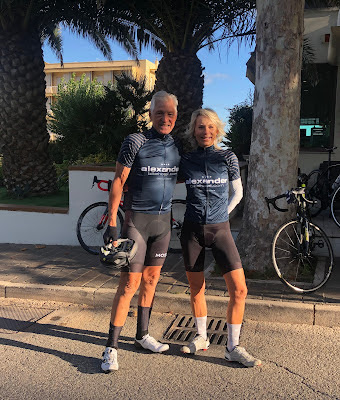
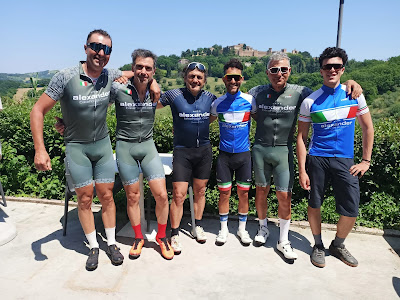









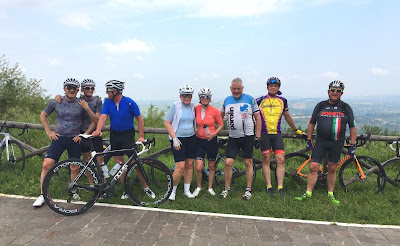









































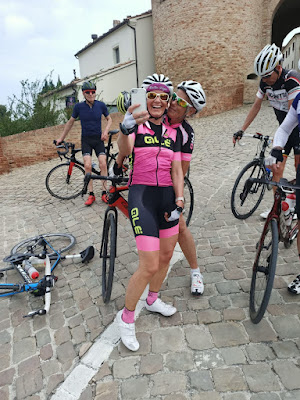




































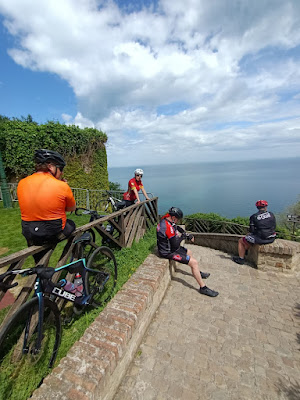



















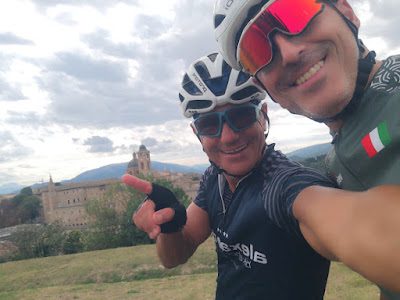




.JPG)
.JPG)
.JPG)
.JPG)
.JPG)


































